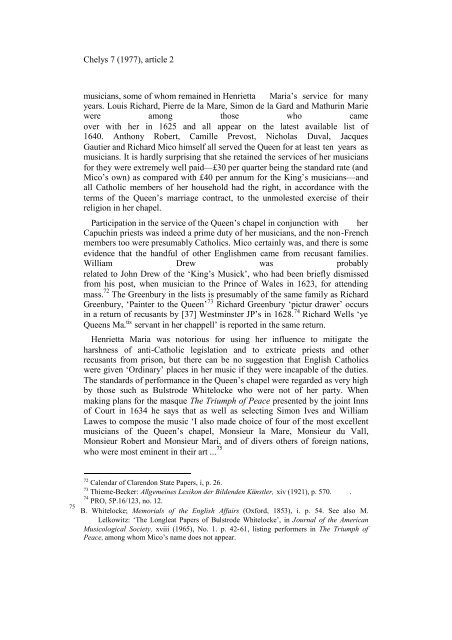download.pdf - 6.3Mb - Viola da Gamba Society
download.pdf - 6.3Mb - Viola da Gamba Society
download.pdf - 6.3Mb - Viola da Gamba Society
You also want an ePaper? Increase the reach of your titles
YUMPU automatically turns print PDFs into web optimized ePapers that Google loves.
Chelys 7 (1977), article 2<br />
musicians, some of whom remained in Henrietta Maria’s service for many<br />
years. Louis Richard, Pierre de la Mare, Simon de la Gard and Mathurin Marie<br />
were among those who came<br />
over with her in 1625 and all appear on the latest available list of<br />
1640. Anthony Robert, Camille Prevost, Nicholas Duval, Jacques<br />
Gautier and Richard Mico himself all served the Queen for at least ten years as<br />
musicians. It is hardly surprising that she retained the services of her musicians<br />
for they were extremely well paid—£30 per quarter being the stan<strong>da</strong>rd rate (and<br />
Mico’s own) as compared with £40 per annum for the King’s musicians—and<br />
all Catholic members of her household had the right, in accor<strong>da</strong>nce with the<br />
terms of the Queen’s marriage contract, to the unmolested exercise of their<br />
religion in her chapel.<br />
Participation in the service of the Queen’s chapel in conjunction with her<br />
Capuchin priests was indeed a prime duty of her musicians, and the non-French<br />
members too were presumably Catholics. Mico certainly was, and there is some<br />
evidence that the handful of other Englishmen came from recusant families.<br />
William Drew was probably<br />
related to John Drew of the ‘King’s Musick’, who had been briefly dismissed<br />
from his post, when musician to the Prince of Wales in 1623, for attending<br />
mass. 72 The Greenbury in the lists is presumably of the same family as Richard<br />
Greenbury, ‘Painter to the Queen’ 73 Richard Greenbury ‘pictur drawer’ occurs<br />
in a return of recusants by [37] Westminster JP’s in 1628. 74 Richard Wells ‘ye<br />
Queens Ma. tis servant in her chappell’ is reported in the same return.<br />
Henrietta Maria was notorious for using her influence to mitigate the<br />
harshness of anti-Catholic legislation and to extricate priests and other<br />
recusants from prison, but there can be no suggestion that English Catholics<br />
were given ‘Ordinary’ places in her music if they were incapable of the duties.<br />
The stan<strong>da</strong>rds of performance in the Queen’s chapel were regarded as very high<br />
by those such as Bulstrode Whitelocke who were not of her party. When<br />
making plans for the masque The Triumph of Peace presented by the joint Inns<br />
of Court in 1634 he says that as well as selecting Simon Ives and William<br />
Lawes to compose the music ‘I also made choice of four of the most excellent<br />
musicians of the Queen’s chapel, Monsieur la Mare, Monsieur du Vall,<br />
Monsieur Robert and Monsieur Mari, and of divers others of foreign nations,<br />
who were most eminent in their art ... 75<br />
72 Calen<strong>da</strong>r of Clarendon State Papers, i, p. 26.<br />
73 Thieme-Becker: Allgemeines Lexikon der Bildenden Künstler, xiv (1921), p. 570. .<br />
74 PRO, 5P.16/123, no. 12.<br />
75 B. Whitelocke; Memorials of the English Affairs (Oxford, 1853), i. p. 54. See also M.<br />
Lelkowitz: ‘The Longleat Papers of Bulstrode Whitelocke’, in Journal of the American<br />
Musicological <strong>Society</strong>, xviii (1965), No. 1. p. 42-61, listing performers in The Triumph of<br />
Peace, among whom Mico’s name does not appear.
















